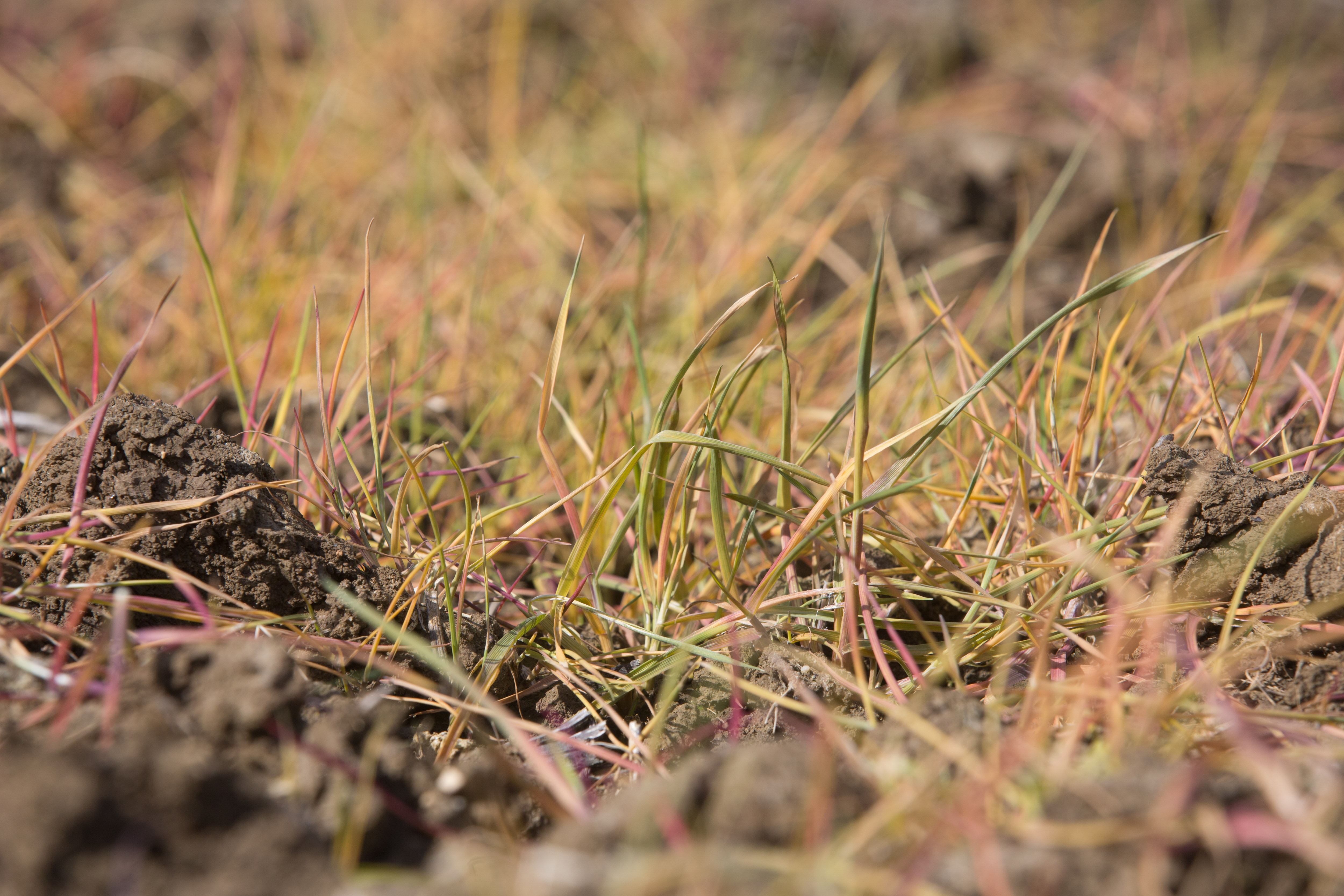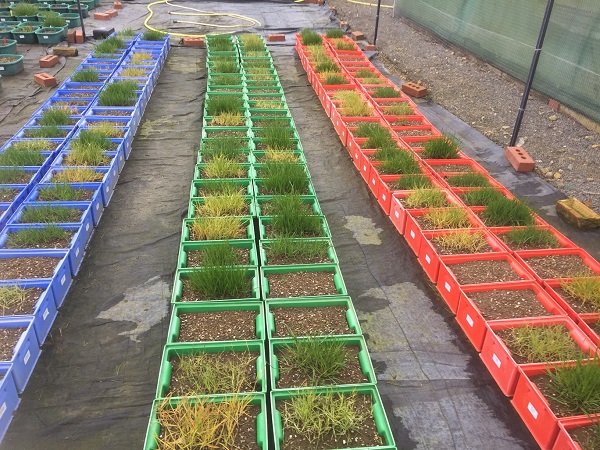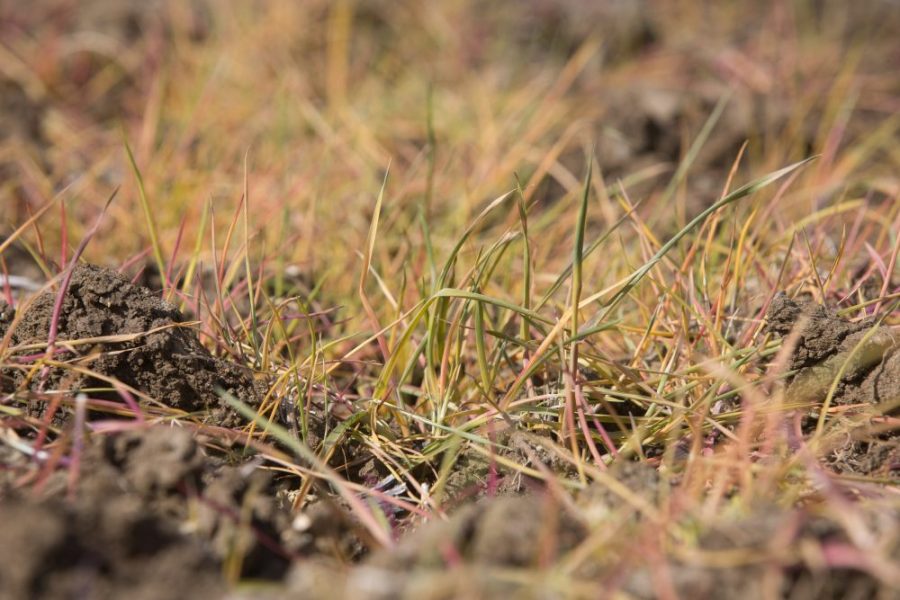
Glyphosate management to minimise the risks of resistance and residues may prove pivotal when its registration comes up for renewal in 2022. CPM finds out about the research that will shape its usage guidelines.
The loss in sensitivity to glyphosate seen in a number of different UK research projects may be the smoking gun.
By Lucy de la Pasture
The bell was tolling for glyphosate as the European Commission reconsidered its renewal towards the end of last year. On this occasion science overcame strong NGO pressure for an outright ban with the result that glyphosate remains available for the next five years. But the heat is still very much on one of the most important pesticides in crop production.

In the first year of the project, researchers carried out container trials to find the optimal growth stage of blackgrass and ryegrass for best control with glyphosate.
The decision whether to make glyphosate available now rests with Member States, who are required to pay ‘particular attention to specific aspects of the risk evaluation process and if necessary, implement risk management measures.’
Although there have been no confirmed cases of glyphosate-resistant weed populations in the UK, examples have been identified in Europe. In the UK there’s already a pro-active approach to glyphosate management, with anti-resistance guidelines introduced in 2015, says AHDB crop protection scientist Dr Paul Gosling.
The guidelines detail how best to use glyphosate as a stale seedbed management tool. Put simply, the strategy is to prevent survivors; maximise efficacy; use alternatives; and monitor success.
James Clarke from ADAS and Weed Resistance Action Group (WRAG) chair says, “AHDB and industry-funded research conducted since 2015 has confirmed these guidelines are robust. They represent the most recent position and, if followed, can help us to avoid the development of glyphosate resistance in the UK.”
It’s an area AHDB has been working on for some time, adds Paul. “We need to be on the front foot when glyphosate is reconsidered by the authorities in 2022.”
That means that as well as minimising the risk of resistance occurring, it’s more important than ever to use glyphosate in a way that minimises any potential impact to human health and the environment. A programme of research is already well underway to underpin and, if necessary, expand industry advice on how to minimise resistance risks and prevent residues in water and produce, explains Paul.
ADAS are leading a five-year programme of work to ensure the existing Weed Resistance Action Group (WRAG) guidelines for glyphosate continue to be as robust as possible. Weed biologist Lynn Tatnell explains that when the guidelines were produced, it became very clear where there was a lack of data to refine them and work needed to be done to fill in the gaps and verify what is known about how to best use glyphosate.
“Glyphosate was introduced in the 1970’s and product labels reflect the grassweed species it was primarily aimed at that time, mainly couch grass. There are no label recommendations or rates for blackgrass and Italian ryegrass, which are the two most invasive grassweed species we’re currently using it to control in the UK.”
ADAS are using a combination of glasshouse container trials and field trials for the research. This allows close monitoring, increased understanding and containment when necessary but ensuring the work remains relevant to field situations.
“We’re using populations with known resistance to several different modes of action because these have a higher risk of becoming tolerant to glyphosate more quickly than a sensitive population,” she explains.
The first year of the research commenced in 2015-16 with container trials to assess the optimum growth stage of the grassweeds for best control in a stale seedbed, and the rate of active ingredient necessary to prevent survivors.
“We found the best timing for glyphosate application is at the 2-3 leaf stage of the weed (GS12-13), with a minimum dose of 540g/ha of the active ingredient. Applying 720g/ha of glyphosate is more advisable in a field situation where other factors can come into play,” she adds.
In the second year of the project, field trials were undertaken at three sites within the UK, with the objective of confirming the results of the previous year’s container trials.
“It’s clear that with a stale seedbed it’s not the number of applications that’s crucial, it’s the quality of the first application. We found two applications were optimal, with the first timed at the 2-3 leaf stage of blackgrass and the second a couple of weeks later when there was a new flush of weeds.
“It’s best to avoid the temptation to go in any earlier because at the one-leaf stage, not enough blackgrass is taken out. But the worst thing to do is to go in too late, once weeds have gone beyond the optimal 2-3 leaf stage, with an insufficient dose of glyphosate,” warns Lynn.
“At timings outside of the optimal window, there’s the biggest concern weeds will be left that have been exposed to glyphosate but survived, and this is a key driver towards resistance,” she explains.
Italian ryegrass is the trickier of the two weeds ADAS have been studying, comments Lynn. “It tends to be more uniform and go through its growth stages more quickly, which can catch you out when it comes to timing glyphosate applications. In Europe, Italian ryegrass is the species that has already developed resistance to glyphosate so it’s something to be aware of. A dose of 720g ai/ha and above is advisable when tackling it in a field situation,” she says.
One of the problems with glyphosate usage is that it’s a chemical that’s been around for decades and users are very familiar with. That means some of the factors which effect its efficacy may be readily forgotten, believes Lynn.
“Glyphosate needs to be used at the right rate at the right time. It’s not unusual to hear of glyphosate being used at 360g ai/ha for stubble cleaning but our trials show that this isn’t high enough.
“It’s also an active that’s very sensitive to calcium ions in the water, so if you’re using hard water, then it needs to be used with a water conditioner to get the best efficacy,” she points out.
This year all glyphosate products are formulated without tallow-amines so it’s particularly important to be tuned into individual product labels to get the best results. “Think about the weather conditions and how this may affect the efficacy of the product you’re using and adjust the rate accordingly,” she suggests.
“Alternatives to glyphosate should be used whenever possible and more than two pre-drilling applications must always be avoided,” adds James. “Any surviving weeds shouldn’t be treated with glyphosate again and any suspected resistance must always be reported and investigated.”
Although no resistance has been detected in the UK, there’s some evidence that in both blackgrass and brome some populations are losing a bit of sensitivity to glyphosate, says Dr Paul Neve, weed scientist at Rothamsted Research.
“It’s a very similar situation to Australia in the lead up to the discovery of glyphosate resistance in ryegrass. Farmers were using more and more glyphosate and resistance evolved. The loss in sensitivity to glyphosate seen in a number of different UK research projects may be the smoking gun,” he says.
As well as resistance, glyphosate has been targeted because of residues found in bread and beer, highlights Paul Gosling. “AHDB have just updated the guidance for pre-harvest use to reemphasize the importance of timing applications correctly to minimise the risks of residues in grain and oilseeds,” he concludes.
Monitoring resistance with RISQ
ADAS are using an in-season resistance test known as RISQ (Resistance In-Season Quick), which was originally developed by Syngenta to detect resistance to post‐emergence acetolactate synthase and acetyl CoA carboxylase herbicides in grass weeds.
“The RISQ test gives us an early indication of tolerance to glyphosate and allows us to identify plants for further screening in container trials,” says Lynn.
The test works by placing small plants and their cleaned roots into a gel containing glyphosate. Within seven days it’s possible to see whether the plants are fully susceptible and will die. Lynn is finding the test is also proving useful to test parts of larger plants and urges any grower concerned about patchy weed control after using glyphosate to get in touch.
Invaluable molecule deserves attention to detail
Over the past decade there’s been an increasing number of industry-led initiatives to steward active ingredients which are under the watchful eye of the regulators. Frontier’s Dr Paul Fogg describes the threat to glyphosate as being in a different league, not least because of the pivotal role it plays in conservation tillage, soil health and managing difficult weeds such as resistant blackgrass.
AIC’s head of agronomy and crop protection, Hazel Doonan, agrees glyphosate has broad and important uses and is ‘potentially irreplaceable’. “As well as playing a crucial part in blackgrass control, glyphosate has significant pre-harvest uses, especially in northern parts of the UK and in the oilseed rape crop for desiccation purposes.
In horticulture glyphosate has many uses, including the removal of weeds around the bases of fruit trees. Its importance extends into the amenity sector, where it’s widely used.
“Within industrial complexes it’s considered best practice to reduce the vegetative cover that can harbour vermin as this helps reduce the need to use rodenticides,” she comments.
Hazel highlights the need to follow glyphosate stewardship guidelines to both ensure it continues to maintain efficacy and in support its continued use beyond 2022. Paul agrees that attention to detail is key when it comes to using or losing this valuable molecule.
“The industry has woken up to using higher rates, but just as important as maintaining the rate are weather conditions, the quality of the application and countering the effects on efficacy in hard water areas,” he says.
Paul suggests that to avoid the cation lock-up hard water causes, the water in the spray tank should receive a conditioner before adding the chemical. He then highlights the part that nozzle choice, appropriate forward speed and correct boom height all have on the efficacy of application.
“Glyphosate needs active growth and its performance will be compromised under very dry or cold conditions,” he says. “This spring many fields were sprayed when it was cool and this was followed by a fortnight of cool, wet weather. When growers were able to get back into the field many reported blackgrass was still present and they had to make a second application of glyphosate to take out the survivors before drilling their spring crops.”
The number of applications of glyphosate to stale seedbeds is one of the areas Frontier is working on with AHDB to discover what’s optimal. “The work so far is showing that two applications of 540g ai/ha followed by a cultivation is the most effective and sustainable way forward
“In practice you have to balance the risk between the number of glyphosate applications and the problem, so there may be a justification for more than this in certain situations in some years. But if you’re in the situation where you do need to apply several applications of glyphosate then a closer look at the whole farming system may prove a better way of addressing the problem,” he adds.
There’s also a water stewardship angle to consider, adds Paul. “It’s best practice not to apply before heavy rainfall because surface run-off risks creating a pathway into water.”
Research roundup
Further information, including the updated pre-harvest guidance, can be found at https://cereals.ahdb.org.uk/glyphosate




